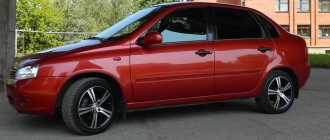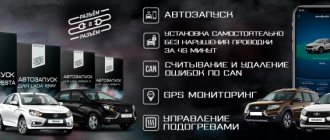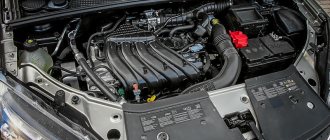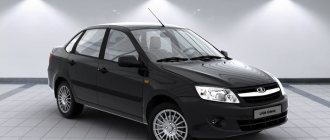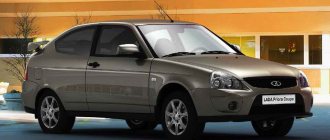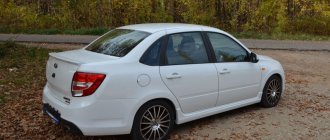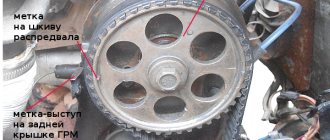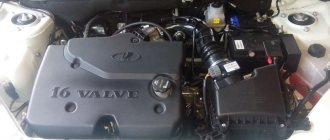DSC_7804
Kalina Cross has become taller, but does not give the impression of an awkward box
The relatively low cost of alterations in factory conditions prompted even the domestic conservative in the person of AVTOVAZ to decide to declare themselves in this niche. Oleg Grunenkov, director of the Lada Granta and Kalina project, openly stated that the appearance of the Cross modification became possible due to a favorable confluence of three circumstances: the low cost of modification, great interest from potential buyers and a rich heritage in developing technical solutions in the process of creating and modernizing the conventional “ Viburnum."
Previously, Za Rulem.RF already published the first impressions of the editor-in-chief of the Za Rulem magazine, Anton Chuikin, from a trip to Kalina Cross. This time, as part of a test on the Kazakh steppes and country roads, a group of journalists were presented with samples of cars from a pilot production batch assembled on the eve of the Moscow Motor Show 2014. According to the assurances of the factory workers, almost the same cars will go into mass production, but minor deficiencies identified even during the current test drive will be eliminated as quickly as possible.
DSC_7761
The 8-valve 1.6-liter engine with an output of 87 hp is already familiar to us from the Ladovsk model range.
There weren’t enough stars in the sky, but we were pleasantly surprised by the good traction at low speeds, the 8-valve 1.6-liter engine with an output of 87 hp, already familiar to us from the Ladovsk model range. there weren’t enough stars in the sky, but I was pleasantly surprised by the good traction at low revs
The 8-valve 1.6-liter engine with an output of 87 hp is already familiar to us from the Ladovsk model range. there weren’t enough stars in the sky, but I was pleasantly surprised by the good traction at low revs
Well, Kalina Cross has become taller, but does not give the impression of an awkward box. There will be only three body colors for now: metallic silver, white and orange (“orange”). According to official data, the increase in ground clearance amounted to a very respectable 23 mm, of which 16 mm are due to the modified suspension geometry (in particular, longer shock-absorbing struts were used), and another 6 mm come from wheels of increased size (195/55R15 instead of the usual old size 195 /50R15). At the same time, to compensate for the increased center of gravity, the wheel track was increased by 4 mm by changing the offset of the discs. Experimental machines are equipped with standard wheels with 2 mm spacers, but production lots will only have wheels with the required offset - 33 instead of 35. Thrifty owners can take note of this nuance. The price for changing the tire size was not only their relatively high price, but also the turning radius increased by 0.3 m. At the same time, the departure/entry angle was 20 degrees - a very good indicator.
The first task is to break out of the center of Almaty, with its chaotic traffic and very peculiar road ethics, onto a suburban highway. The habitual “he who owns the more expensive car is right” common to locals forces even Muscovites to be extremely careful. This is helped by generally good visibility and matte-dark trim panels that do not glare in the bright sun, but the lack of electrical adjustment of the right outside rear view mirror is a serious disadvantage in modern traffic conditions.
Lada Kalina Cross
There are only two trim levels of the Lada Kalina Cross car - standard and luxury, which in turn are also divided depending on the installed engine and gearbox, resulting in as many as 14 trim levels, the cheapest ones are equipped with an 8-valve engine with a capacity of 87 horsepower, which works exclusively with manual transmission. Let's take a closer look at the configuration of Kalina Cross.
21941-51-C10 and 21941-51-C11
The “norm” package includes an 8-valve 1.6-liter engine with an output of 87 horsepower, a 5-speed manual transmission. Both configurations are completely identical except for the interior – orange or gray; in addition, the package includes:
- Driver airbag;
- 2 rear seat headrests;
- ISOFIX child seat anchorage;
- Immobilizer;
- Security alarm;
- Daytime Running Lights;
- Anti-lock braking system ABS+BAS;
- Electronic brake force distribution system;
- On-board computer;
- Gear shift prompt in the instrument cluster;
- Electric power steering;
- Central locking with remote control;
- Power windows for front doors;
- Heated front seats;
- Electrically heated exterior mirrors;
- Climate system;
- Side door moldings and roof rails.
Not a bad package for the cheapest “norm”, price – 524 thousand 100 rubles.
21947-51-C10 and 21947-51-C11
The standard equipment is exactly the same as the previous models, but is additionally equipped with a front passenger airbag. The engine is already 16-valve with a capacity of 106 horsepower, and the gearbox is 5-speed manual. The cost is slightly more expensive - 541 thousand rubles.
Black line 21947-51-C13 and 21947-51-C12
The latest configuration is “norm” with a 106-horsepower engine and manual transmission. Unlike previous models, the roof of the cars is painted black, there are vinyl stickers on the floor sills, in addition, cars of the Black line line are equipped with original 15-inch wheels. The price for a dubious advantage is 9 thousand rubles more expensive (550 thousand rubles).
21947-52-C10 and 21947-52-C11
And this is a luxury package with a 16-valve engine producing 106 horsepower and a manual transmission. In addition to what is already included in the “norm”, the package includes:
- 3 rear seat headrests;
- Fog lights;
- Headlight switch-off delay function;
- Electric drive of external mirrors;
- Heated windshield;
- Parking, rain and light sensors;
The price of this modification is 568 thousand rubles.
21947-51-C50 and 21947-51-C52
The “norm” package with a 106-horsepower engine and a robotic 5-speed gearbox is equipped with fog lights. In all other respects they are similar to modifications 21947-51-C10 and 21947-51-C11. Price 569 thousand rubles.
Black line 21947-51-C54 and 21947-51-C53
Exactly the same configurations as the previous Black line series, but with a robotic gearbox. Price 578 thousand rubles.
21947-52-C50 21947-52-C51
Another “luxury” package, but unlike the previous luxury, it features a robotic gearbox. Price 593 thousand rubles.
IMG_2765
There are no complaints about the operation of the controls, everything works and turns on as expected, there is no need to pay special attention to anything. This is supported by a modernized clutch drive, a vacuum brake booster with a pedal, and - finally! — cable drive gearbox, like the “countryman” Datsun on-DO. Some factory workers spoke of such a set of modernized components in one model almost as a revolution, but the consumer has the right to believe that this should have become the norm long ago. And the old defect - the whine of gears in the manual transmission, especially in lower gears - has not been eliminated by the plant for almost 30 years, that is, ever since the 2108 family entered the main assembly line.
Soon we are promised versions with automatic transmissions (the classic “automatic” or “robot” from Priora AMT has not yet been decided, but there will definitely be no CVTs yet), and the usual five-speed “mechanics” will apparently survive with a proprietary defect until the very end, which is especially offensive given the improved sound insulation of the cabin, when transmission noise becomes especially noticeable.
The second discipline is the behavior of a moderately loaded car (three adults with small luggage) on the highway. Here it is immediately worth noting the characteristic features of Kazakhstani roads far from large cities, where the asphalt surface is usually several decades old. During this time, large-capacity trucks have rolled very noticeable ruts, and the road profile itself resembles a washboard. The only plus is that there are practically no large holes in which you can tear a tire or break a disk: road services can at least cope with this.
Such driving conditions pose quite a serious challenge to the performance of the suspension. To the credit of the VAZ team, we must admit that they coped with this almost perfectly, which is especially pleasant against the backdrop of the old problems with the Kalina suspension. The current one in the Cross model is made on the basis of the most successful 928 modification with gas-filled shock absorbers (again, hello to the French-Japanese who came to Tolyatti). Despite the slightly increased rigidity, stability and indifference to changing lanes between tracks remained at a high level - this was noted by all crew members who were alternately drivers and passengers.
DSC_7962
The 8-valve 1.6-liter engine with an output of 87 hp is already familiar to us from the Ladovsk model range. There weren’t enough stars in the sky, but I was pleasantly surprised by the good traction at low speeds, especially taking into account the compliance with Euro-4 toxicity standards. To compensate for the increased mass (+15 kg) and increased drag (C x - from 0.4 to 0.42), a main pair with a gear ratio of 3.9 was used instead of the 3.7 that the plant had been accustomed to since 1985. This inevitably led, according to official factory data, to a decrease in top speed by 3 km/h and an increase in fuel consumption by 0.2 l/100 km. But in any case, the power supply of a car with this engine is enough for safe driving on the highway at speeds of up to 120 km/h. If this threshold is exceeded, overtaking becomes dangerous even on half-empty Kazakhstani highways. In October, Tolyatti residents promise to start equipping the Kalina Cross with 16-valve engines producing 106 hp. - this option looks much more interesting, but you will have to come to terms with an increased tax rate and a higher purchase price.
Having turned onto a steppe country road connecting the Almaty-Karaganda highway with the western shore of Lake Balkhash (this was the third test discipline), we could not resist the temptation to check the real parameters of geometric cross-country ability and the operation of the suspension at speeds of 80–100 km/h. The mode was simple: after acceleration, we engage third gear and drive only in it under any road conditions - this way we limit the reasonably safe maximum speed and force the driver not to slow down on bumps so much that a lower gear would be required. The car coped with this exercise almost perfectly - there were no bumpers touching the ground, and we lightly and harmlessly touched the ground with the crankcase protection only twice. If there had been only one driver in the car, I’m sure this could have been avoided.
Lada Kalina Cross technical specifications
Under the hood of a VAZ car, one of two types of engines can be installed, these are:
- 8-valve injection internal combustion engine 87 l. With.;
- 16 valve engine (also injector) 106 hp. With.
All power units are four-cylinder, in-line, running on gasoline fuel, with a cylinder capacity of 1596 cm3.
The type of recommended fuel is AI-95 gasoline; the engines comply with Euro-4 environmental standards.
There are also two types of gearboxes: five-speed manual and robotic gearbox-5.
In the standard version with an 8-valve transmission and a 5-speed manual transmission, the car can be accelerated to 165 km/h and hit a hundred in 12.2 seconds.
The manufacturer states that in the combined cycle, gasoline consumption per 100 km is 7.2 liters.
With an AMT transmission and a 106-horsepower engine, the car consumes fuel more economically (7 liters), but acceleration is not fast; it will take 13.1 seconds to reach 100 km/h.
But the maximum speed in this configuration is higher; the Cross 1.6 AMT can travel at a maximum speed of up to 178 km/h.
Compared to the station wagon, the ground clearance of the Lada Cross is increased by 2.3 centimeters and is 208 mm (without load). With a body length of 4.104 m, Kalina’s wheelbase is 2476 mm, and the car’s height is 1.7 m.
The front suspension of the Cross is standard - standard MacPherson strut.
But a beam is installed at the rear, but it is reinforced with triangular arms.
The front brakes are disc (there are no other brakes on modern passenger cars now), but there are drums on the rear axle, which, of course, is not encouraging.
The electric power steering made driving the car easy, and changing the gear ratio in the main gearbox from 3.7 to 3.9 improved traction characteristics, but due to this the dynamics deteriorated slightly.
DSC_7825
Only a Toyota Land Cruiser prepared for off-road with a steel cable solved this problem.
Only a Toyota Land Cruiser prepared for off-road with a steel cable solved this problem.
This problem was solved only by a Toyota Land Cruiser prepared for off-road use with a steel cable.
At the same time, we will also mention a funny incident on the shore of a small lake near the road. While everyone went out to warm up, the car literally fell into quicksand wet soil up to the hubs in just a few minutes. Attempts, even with the help of colleagues, to push it out under its own power did not lead to anything, and the problem was solved only by a Toyota Land Cruiser prepared for off-road use with a steel cable. Subsequent inspection showed that the parts on the underbody and the plastic on the body and bumpers were completely undamaged from the belly seat, but the rear towing eye was deformed. It is noteworthy that the size of the cutout for it turned out to be insufficient, and the bumper itself received traces of contact with the cable - a typical case when, in pursuit of design, they forgot about functionality.
This accidental incident prompted an unplanned vibration test. The irony of fate was that a large amount of greasy dirt was firmly stuck to the wheel rims, which was not possible to wash off on site, and we did not encounter a single car wash on the highway! As a result, the next few hundred kilometers were spent on a vibration test bench. The day before, Kalina Cross designers talked for a long time about detailed work to eliminate all kinds of vibrations, squeaks and noise, but here it turned out to be the opposite. As we drove, under the influence of centrifugal forces, the dirt gradually fell off the wheels, which provided interesting material for observing the limits of noise and squeaks, which we honestly shared with the factory workers. They, in turn, promised to carefully analyze everything. There is no particular point in dwelling on this in detail; after all, the cars were from an experimental batch, but the poor fit of the driver’s and rear right doors, which caused a lot of creaking of the seals and the penetration of dust, cannot be ignored. We can only hope that this was a flaw in a specific instance, and buyers should pay special attention to these details when purchasing.
Features of the VAZ-11186 engine (87 hp)
| Type | gasoline (AI-95) |
| Volume | 1597 cm3 |
| Maximum power | 64.2 kW (87 hp), at 5100 rpm |
| Maximum torque | 140 +/- 3 Nm, at 3800 rpm |
| Configuration | in-line, 4-cylinder. |
| Cylinders | 4 |
| Valves | 8 |
| Max. speed | 188 km/h |
| Combined fuel consumption | 7.3 l/100 km |
| Fuel consumption in the urban cycle | 8.5 l/100 km |
| Fuel consumption on the highway | 5.7 l/100 km |
| Environmental standards | Euro 4 |
| Cylinder diameter | 82 mm |
| Piston stroke | 75.6 mm |
| Compression ratio | 10.6 |
| Supply system | phased injection |
This is a modernized VAZ-11183 engine, which has more power by reducing the weight of the piston group by thirty-nine percent. This motor has proven itself well and can be confidently called reliable. We won’t dwell on it, let’s just say that in the event of a timing belt break, the valve does not bend, and its technical parameters and cost are the same as those of the VAZ 21116 engine:
DSC_7864
The rear towing eye was deformed.
It is noteworthy that the size of the cutout for it in the bumper turned out to be insufficient, and it clearly bore traces of contact with the cable - a typical case when, in pursuit of design, they forgot about functionality. The rear towing eye was deformed. It is noteworthy that the size of the cutout for it in the bumper turned out to be insufficient, and it clearly bore traces of contact with the cable - a typical case when, in pursuit of design, they forgot about functionality
The rear towing eye was deformed after being rescued. It is noteworthy that the size of the cutout for it turned out to be insufficient, which is why the bumper received traces of contact with the cable - a typical case when, in pursuit of design, they forgot about functionality
Another drawback, which many test participants spoke about closer to the finish line of this difficult but interesting Kazakh 1200 km, is the anatomical properties of the seats. Here there was only one verdict - staying in them for a long time is very uncomfortable. And even though, compared to the previous ones from the base Kalina, they have been modified to improve lateral support, decorative colored inserts and stitching have appeared, and elements for fastening child seats according to the isofix standard have been added, in its current form it still looks more like a mockery of riders.
And finally, about market prospects. Compared to its “donor” - the regular Kalina station wagon - a new product in a similar configuration (for now it will be “Norma”) costs only 17 thousand rubles. more expensive, while having undeniable advantages in suspension, gearbox, and geometric cross-country ability. AVTOVAZ's marketing service estimates demand in 2015 at 15 thousand cars, and Oleg Grunenkov announced the plant's readiness to triple production of the Lada Kalina Cross. Hard times are coming for the closest relative-competitor of the Renault Sandero Stepway (price in showrooms starts from 510 thousand rubles).
Lada Kalina Cross: berry selection
Lada Kalina Cross engine technical specifications, device
The Lada Kalina Cross engine is already known from other Lada models, as it is widely used. Therefore, problems with maintenance and spare parts should not arise. This is a gasoline engine with 87 hp. having a working volume of 1.6 liters. Engine model Kalina Cross VAZ-11186 .
This is an 8-valve power unit, where a timing belt is used in the timing drive. In fact, this is the same VAZ-11183 producing 82 hp, but with some modifications that increased power and torque. So the main difference is the use of lightweight elements of the connecting rod and piston group. This allowed not only to increase power, but also to reduce fuel consumption.
The four-stroke power unit meets EURO 4 environmental standards; the engine uses phased distributed fuel injection in the power system. The fuel itself is AI-95 gasoline. Below are more detailed characteristics of the Lada Kalina Cross engine .
Lada Kalina Cross engine, fuel consumption, dynamics
- Working volume – 1596 cm3
- Number of cylinders – 4
- Number of valves – 8
- Power hp – 87 at 5100 rpm
- Power kW – 64 at 5100 rpm
- Torque – 140 Nm at 3800 rpm
- Cylinder diameter – 82 mm
- Piston stroke – 75.6 mm
- Compression ratio – 10.6
- Timing Drive - Belt
- Maximum speed – 165 kilometers per hour
- Acceleration to the first hundred – 12.2 seconds
- Fuel consumption in the city – 9.5 liters
- Fuel consumption in the combined cycle – 7.2 liters
- Fuel consumption on the highway – 6.1 liters
As for the Lada Kalina Cross transmission , the manufacturer installs a manual 5-speed gearbox with cable drive. The same transmission can be found on other Lada models. The gear ratio of the main pair is 3.9.
Like the regular Kalina, the Kalina Cross version has exclusively front-wheel drive. All sorts of talk about the appearance on the market of an all-wheel drive version of Kalina Cross 4x4 has been wandering at the level of rumors for quite some time. However, the manufacturer itself officially states that there will be no all-wheel drive on the Lada Kalina Cross in the near future.
Source

